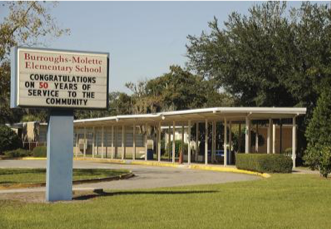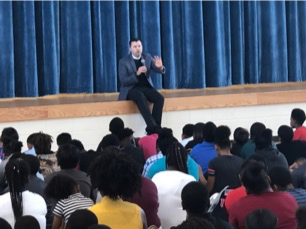
This past Sunday I preached about the ongoing need to support Burroughs-Mollette Elementary School (BMES) in Brunswick. BMES is still the poorest school in Glynn County, and actually for several counties around (based on the percentage of students who qualify for free and reduced lunches). When compared with all the elementary schools in Glynn, Brantley, McIntosh, and Camden Counties, Burroughs Mollette is the poorest by this measure. And, as research has shown over and over again, poor schools, where the majority of students are poor, have worse outcomes academically. It’s not so much that children in poverty can’t learn and can’t excel, but rather that when a school is predominantly poor, there is a strong negative correlation between that widespread poverty and performance on standardized measures. [Photo Credit: The Brunswick News]
On one hand, I could not care less about standardized test scores. I think standardized testing is ruining education in many parts of the country. We tend to lay a lot of our complaints at the feet of the Common Core standards, yet teaching for standardized tests has a long history before the current standards became the measuring stick. This leads to an unhelpful system of awarding teachers, principals, schools, and school districts based on the standardized scores that are recorded each year. The anxiety that accompanies such systems is palpable all the way from Atlanta, down to my dining room table. This might ultimately be a way to get some special attention for schools like BMES in the end, but I doubt it. When we realize that poor schools will rarely measure up on achievement measurements, maybe we’ll decide to change the school make-up or change the way we measure the students.
I say this because there is research that shows that poor schools can measure the same growth as wealthier schools, maybe even better growth. That is, when the measure is not a standardized universal instrument that puts all children of a particular age in the same category, but is instead based on individual achievement and growth over a period of time, poor schools canhold their own. In some cases, poor schools are able to achieve higher growth scores than their wealthier counterparts, yet such results are rarely quantified or rewarded. Poor students tend to start behind their peers, which means they finish behind their peers, which means they will often lose out on comparative systems of reward. The standardized scores of poor schools will always lag, sometimes dramatically. That helps explain why BMES’ GA Milestone scores (the GA standardized tests for 3-5thgrade) range from 2.5 to 15.2 on a scale of 100 for the various grades and elements of testing. This compares to scores that range from 66.3 to 88.2 at the county’s wealthiest school, Oglethorpe Pointe Elementary. Keep in mind that students from similar neighborhoods to BMES students tend to perform better at the wealthier schools they are bused to. It’s not an ability issue, it’s a poverty issue.
To overcome the poverty challenge in education takes a great deal of resources, commitment, and creative thinking. It can be done. When I mentioned Lebron James’ efforts in Akron, OH, on Sunday, it was a prime example of what creative approaches can achieve. While the kids in the school he supports still lag behind wealthier schools in standardized test scores, 90% of the kids in the school outperformed 99% of students nationally, when measuring individual growth (when comparing pre and post-test scores). If those efforts can be replicated semester over semester, year over year, grade over grade, it is feasible that students once written off as lost causes could end their public school careers on par with their peers who face far fewer challenges in academic achievement. It’s a hope, and it’s a start, and we have to start somewhere.
And what does this have to do with us? It means we need to get active and creative, and most importantly, hopeful about what is possible for BMES in the future. To that end, we are going to continue our efforts to support the school overall, recognize teachers, and continue facilitate tutoring for afterschool and dyslexia spectrum kids, among other outreach initiatives. We are going to reward kids for their standardized test scores, in part to celebrate high achievers, and also to help others learn that (even though many of us don’t like them) standardized test scores matter to the school and the future success of their school. Think of it as apathy-busting and excellence-rewarding at the same time. We’re also going to start a reward program at the school through Glynn Episcopal Ministries. Borrowing ideas from what works in better resourced schools, I think we can establish an instant reward program that incentivizes achievement in reading, math, and behavior all at the same time.
When children are rewarded as they do something, research shows it can be a huge motivator. Grades and test scores aren’t big motivators for most kids, especially those who know that they tend to get more wrong answers than right ones. Finding ways to celebrate the small successes and small gains is not a throwaway; it is the only way. We’ll need some volunteers to help put the program together and support teachers in using it. We’ll also need some financial resources and donations to provide the incentives. If we are able to create a “Tiger Dollar” system, the kids can accrue dollars for successes, and then use them to buy things in a “store” that would be open once a quarter and offer everything from toys to books to candy. Every child has a chance to earn rewards, not just the high achievers.
I’m going to put it on the calendar right now: Sunday, June 23, I am going to host a meeting at 12:30 pm for those who want to help think through how we can facilitate such a program. Please join me if you have ideas or interest in something like this. And if this isn’t your thing, consider being a mentor or a tutor. You need to attend a training session in order to go into the schools, but these programs change lives. Te Boles’ dyslexia tutoring outreach is also a good place to invest your energy. She will train volunteers how to administer the Barton Method, and the more tutors we have, the more kids we’ll be able to help.

This past week I spoke to the entire student body at BMES as a part of an end-of school assembly. These are kids who are more than numbers and test scores. These are kids who, in some cases, are living in situations I can scarcely imagine. The heartbreaking thing is that you can see it on some – not all – of their faces. But I won’t let myself see a gymnasium full of kids for whom there is no hope. I want to work with the school; with teachers and staff; with the parents who are able to raise the bar; with a community that cares for these kids, as if they are their own, and give it everything we’ve got to make it better. I don’t think we can eliminate the poverty in the near future, per se, but a generation or two of better-educated children will certainly help. Kids who grow up to have options, real options for a better life, whose own kids will then have options for more success, is where my hope lies. Hope, with a lot of love and a lot of hard work, is really all we need.
Tom+
God of knowledge and wisdom, we pray to you for all the schools across this country. We remember them in their variety, in their differences, and in what they share. Give us open doors, open minds, and open hearts that we might accept, learn, and love everything and everyone whom you give to us to teach. Help us to share our lives and what we have, and to learn from all those who are in our schools. We pray in the name of Jesus who opened his arms to all, young and old. Amen.
Adapted from a prayer by John F. Smith
